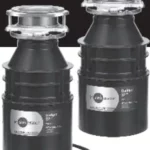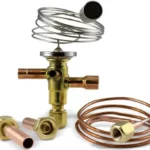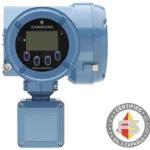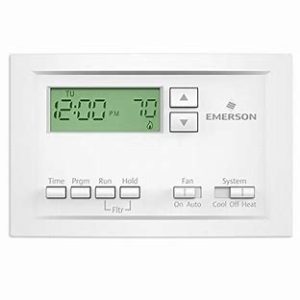
Want to install the easy way?

Single-Stage Thermostat
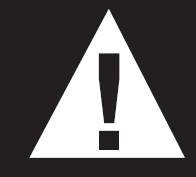
1. PREPARATIONS
1.1 Check package contents
This package should contain the following items: 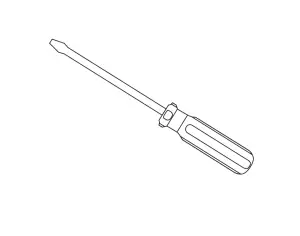
- Thermostat
- Mounting screws and wall anchors (x2)
- 2 AAA batteries
- Terminal wire label stickers
- Installation instructions
1.2 Gather tools
Required tools:
- Flat-head Screwdriver □ Small pliers (needle-nose) □ Drill with 3/16” (4 mm) bit
Optional tools: - Wire cutters/stripper □ Hammer
2. THERMOSTAT DETAILS
The thermostat buttons and switches
- Raises temperature setting.
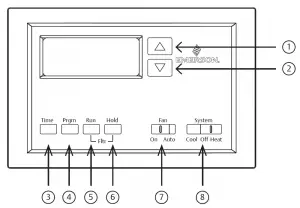
- Lowers temperature setting.
- TIME button.
- PRGM (program) button.
- RUN (run program) button.
- HOLD temperature button.
- FAN switch (ON, AUTO).
- SYSTEM switch (COOL, OFF, HEAT).
3. REMOVING OLD THERMOSTAT
3.1 Turn off power
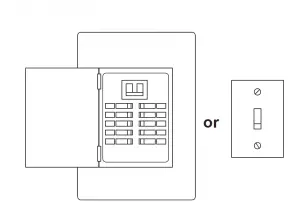
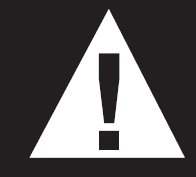
To ensure the power to your heating and cooling system has been turned off, try to turn on heating or cooling by changing the temperature on your old thermostat.
3.2 Remove the old thermostat cover
Remove the old thermostat’s front cover from the wall base. Some covers pull off easily, while others may need to be removed by prying the cover off with a screwdriver.

For safe disposal information, please see Mercury Notice on page 43.
3.3 Label wires
Tip: Taking a picture with a camera or smartphone can help you not only remember how wires are connected to the terminals, but can also ensure that you label your wires correctly.
Using your screwdriver, carefully unscrew one wire at a time from the terminal block and attach the corresponding wire label sticker.
Please note that not all terminals may be used, and that there’s no standard color code for thermostat wires, so your wire colors may vary. For your reference, we’ve included a terminal label reference chart on page 7 to help you connect the wires in your old thermostat to your new thermostat in case you get stuck.
Terminal labeling reference chart

3.4 Identify jumper wire
| On your old thermostat, if… | Then, on your new thermostat… |
| Terminal RC and RH are connected with a jumper wire |
Leave the jumper wire in its place |
| There’s only one R wire (RC, RH, R or R5) coming out of the wall | Leave the jumper wire in its place |
| Terminal RC and RH (or 5 or R5) are NOT connected by a jumper wire | Remove the jumper wire between RC and RH |
For terminal Y and W:
If you have a heat pump with reversing valve, connect Y and W with a jumper wire on your new thermostat.
If you need help with labeling and wiring, please contact Customer Support at 877.654.9394 or email
[email protected] — we’re here to help!
3.5 Remove old thermostat base
With all of your wires disconnected and properly labeled, you may now safely remove the thermostat base from your wall.

Tip: Worried about having your wires falling into your wall? Keep the wires secure by wrapping the them around a pencil.
4. MOUNTING AND WIRING YOUR NEW THERMOSTAT
4.1 Install new thermostat base

Mount your new thermostat base using the supplied screws. Drill holes and insert wall anchors to secure the thermostat base to the wall, if necessary.
4.2 Connect wires to corresponding terminal blocks
Match each labeled wire to it’s corresponding terminal on the mounted thermostat base. Insert each labeled wire into the hole of it’s matching terminal, and using the screwdriver, tighten the screw on the terminal block securely.
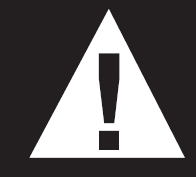
4.3 Set switch and advanced wiring
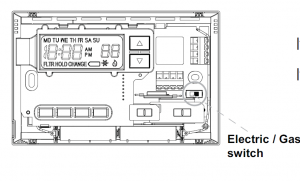
If you have an electric furnace, set the switch to ELEC.
4.4 Install the batteries and attach front cover
Install the included AAA alkaline batteries and push the front cover on to the thermostat base until it’s secure.
4.5 Turn on power
Turn on your power at the source.
Congratulations! You’ve completed the thermostat installation process
5. CHECK THERMOSTAT OPERATION
Tip: If at any time during testing your system does not operate properly, please contact Customer Support at 877.654.9394 or email [email protected]
5.1 Fan operation
If your system does not have a G terminal connection, skip to 5.2 Heating system.
- Move FAN switch to ON position. The blower should begin to operate.
- Move FAN switch to AUTO position. The blower should stop immediately.
5.2 Heating system
- Move SYSTEM switch to HEAT position. If the heating system has a standing pilot, be sure to light it.
- Press
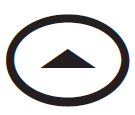
- Press

5.3 Cooling system

- Move SYSTEM switch to COOL position.
- Press

- Press

5.4 Typical wiring diagrams
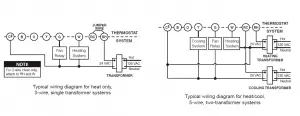

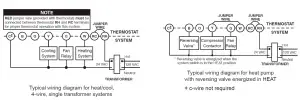
6. PROGRAMMING YOUR THERMOSTAT
Before you begin programming your thermostat, you should be familiar with its features and with the display and the location and operation of the thermostat buttons. Your thermostat consists of two parts: the thermostat cover and the base. To remove the cover, pull it straight out from the base. To replace the cover, line up the cover with the base and press until the cover snaps onto the base.
6.1 The thermostat buttons and switches
- Raises temperature setting.
- Lowers temperature setting.
- TIME button.
- PRGM (program) button.
- RUN (run program) button.
- HOLD temperature button.
- FAN switch (ON, AUTO).
- SYSTEM switch (COOL, OFF, HEAT).
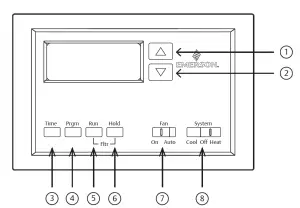
6.2 The display
- Indicates day of the week.
- Flame icon () is displayed when the SYSTEM switch is in the HEAT position. Snowflake icon ()is displayed (non-fl ashing) when the SYSTEM switch is in the COOL position. Snowflake is displayed (fl ashing) if the thermostat is in lockout mode to prevent the
compressor from cycling too quickly. - Displays “CHANGE ” when the 2 “AAA” batteries are low and should be replaced.
Only “CHANGE ” and “LO” in the minutes field are displayed when batteries are low with no system power. - Alternately displays current time and temperature. Displays “LO” in the minutes field when batteries are low.
- The word “HOLD” is displayed when the thermostat is in the HOLD mode. “HOLD” is displayed fl ashing when the thermostat is in a temporary HOLD Mode.
- Displays currently programmed set temperature (this is blank when SYSTEM switch is
in the OFF position). - Displays “FLTR” when the system has run for the programmed filter time period as a reminder to change or clean your air filter.
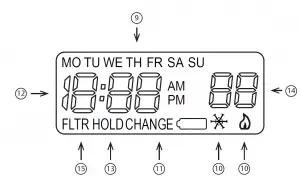
6.3 Configuration menu
The configuration menu allows you to set certain thermostat operating characteristics to your system or personal requirements.
Press RUN to make sure the thermostat is in the run program mode, then press PRGM and RUN at the same time to enter the configuration menu. The display will show the first item in the configuration menu.
The configuration menu table summarizes the configuration options. An explanation of each option follows.
Press HOLD to change to the next menu item or press TIME to go backwards to the previous item in the menu. To exit the menu and return to the program operation, press RUN. If no keys are pressed within fifteen minutes, the thermostat will revert to normal operation.
1. Select Temporary Hold Time – The thermostat can hold any temperature you set it to for the amount of time you select on this option. Your choices are 0:00 to 8:00 hours in 15 minute increments. 0:00 disables the function
Example:
- You have selected 3:00 hours for the Temporary Hold time period.
- With the thermostat set to Heat or Cool, press HOLD for approximately five seconds until HOLD time (3:00 indicating 3 hours) appears as a setting reminder.
- After releasing the button, “HOLD” on the display will blink.
- Use


2. Select FA or SL (Fast or Slow) Heating Cycle Rate – The FA setting is frequently used for gas, oil or electric heat. The SL setting produces a longer heating cycle which is normally for hot water or steam (hydronic) systems. Both settings produce very accurate temperature control and can be set to your personal preference. FA cycles the system just under 1°F and the SL setting cycles at approximately 1.5°F.
3. Select backlit display – The display backlight improves display contrast in low lighting conditions. Selecting backlight ON will keep the light on for a short period of time after any key is pressed. Selecting OFF will keep the light off.
4. Select Energy Management Recovery OFF or ON – Energy Management Recovery (EMR) causes the
thermostat to start heating or cooling early to make the building temperature reach the program setpoint at the time you specify. Heating will start 5 minutes early for every 1° of temperature required to reach setpoint.
Example:
You select EMR and have your heating programmed to 65° at night and 70° at 7 AM. If the building temperature is 65° the difference between 65° and 70° is 5°. Allowing 5 minutes per degree the thermostat setpoint will change to 70° at 6:35 AM. Cooling allows more time per degree because it takes longer to reach temperature.
5. Select filter replacement run time – The thermostat will display “FLTR” after a set time of operation. This is a reminder to change or clean your air filter. This time can be set from 0 to 1950 hours in 50 hour increments. A selection of 000 will cancel this feature. When “FLTR” is displayed, you can clear it by pressing HOLD and RUN at the same time. This resets the timer and starts counting the hours until the next filter change. Changing the time in the menu also resets the timer.
6. Select Compressor Lockout LOC OFF or ON – Selecting LOC ON will cause the thermostat to wait 5
minutes before turning on the compressor if the heating and cooling system loses power. It will also wait a
minimum of 5 minutes between cooling cycles. This is intended to help protect the compressor from short cycling. Some newer compressors already have a time delay built in and do not require this feature. Your
compressor manufacturer can tell you if the feature is already present in their system. When the compressor time delay occurs it will fl ash the (snowfl ake icon) for about five minutes then turn on the compressor.
7. Select Temperature Display Adjustment 4 LO to 4 HI – Allows you to adjust the room temperature display
+/- 4°. Your thermostat was accurately calibrated at the factory but you have the option to change the display temperature to match your previous thermostat.
8. Select F° or C° Readout – Changes the display readout to Celsius or Fahrenheit as required.
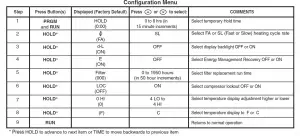
6.4 Operating features
This section contains information about the many features of your new thermostat.
- SIMULTANEOUS HEATING/COOLING PROGRAM STORAGE — When programming, you can enter both your heating and cooling programs at the same time. There is no need to reprogram the thermostat at the beginning of each season.
- TEMPERATURE OVERRIDE — Press


The thermostat will override current programming and keep the room temperature at the selected temperature
until the next program period begins; then, the thermostat will automatically revert to the program. - HOLD TEMPERATURE — The thermostat can hold any temperature within its range for an indefinite period without reverting to the programmed temperature. To engage this feature, press HOLD button. “HOLD” will be displayed. Then choose the desired temperature by pressing


- CONFIGURATION MENU — Allows you to customize certain thermostat options.
6.5 Programming your thermostat
This section will help you plan your thermostat’s program to meet your needs. For maximum comfort and efficiency, keep the following guidelines in mind when planning your program:
- When heating (cooling) your building, program the temperatures to be cooler (warmer) when the building is vacant or during periods of low activity.
- During early morning hours, the need for cooling is usually minimal.
Planning your program
Look at the factory pre-programmed times and temperatures shown in the sample schedule. If this program will suit your needs, simply press the RUN button to begin running the factory preset program.
If you want to change the pre-programmed times and temperatures, follow these steps.
Determine the time periods and temperatures for your weekday and weekend programs. You must program
four periods for both the weekday and weekend program. However, you may use the same heating and cooling temperatures for consecutive time periods. You can choose start times, heating temperatures, and cooling
temperatures independently for both weekday and weekend programs (for example, you may select 5:00 AM and 70° as the weekday 1st period heating start time and temperature, and also choose 7:00 AM and 76° as the weekday 1st period cooling start time and temperature).
SAMPLEHeating/Cooling Schedule Plan (Factory Program)

Use the following table to plan your program time periods and the temperatures you want during each period. Fill in the complete table to have a record of your programs.
Heating/Cooling Schedule Plan
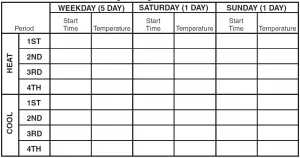
Entering your program
Follow these steps to enter the heating and cooling programs you have selected.
Set Current Time and Day
- Press TIME button once. The display will show the hour only.
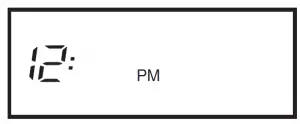
- Press and hold either


- Press TIME once. The display window will show the minutes only.
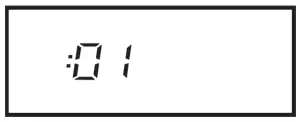
- Press and hold either


- Press TIME once. The display will show the day of the week.
- Press


- Press RUN once. The display will show the correct time and room temperature alternately.
Set Heating Program
- Move the SYSTEM switch to HEAT.
- Press PRGM once. “MO TU W TH FR” (indicating weekday program) will appear in the display. Also displayed are the currently programmed start time for the 1st heating period and the currently programmed temperature (fl ashing).
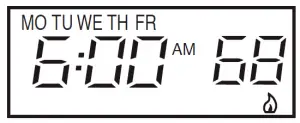 This display window shows that for the 1st weekday period, the start time is 6:00 AM, and 68° is the
This display window shows that for the 1st weekday period, the start time is 6:00 AM, and 68° is the
programmed temperature (this example refl ects factory preprogramming). - Press


- Press TIME once (the programmed time will fl ash). Press


- Press PRGM once. The currently programmed start time and setpoint temperature for the 2nd heating program period will appear.
- Repeat steps 3 and 4 to select the start time and heating temperature for the 2nd heating program period.
- Repeat steps 3 through 5 for the 3rd and 4th heating program periods. Weekday heating programs are now complete.
- Press PRGM once. “SA” (indicating Saturday program) will appear in the display, along with the start time for the 1st heating period and the currently programmed temperature.
- Repeat steps 3 through 7 to complete Saturday heating programming.
- Press PRGM once. “SU” (indicating Sunday program) will appear in the display, along with the start time for the 1st heating period and the currently programmed temperature.
- Repeat steps 3 through 7 to complete Sunday heating programming.
- When you have completed entering your heating program, press RUN.
Set Cooling Program

- Move SYSTEM switch to COOL position.
- To set your cooling program, follow the same procedure as setting your heating program, but use your selected cooling times and temperatures.
Check your programming
Follow these steps to check your thermostat programming one final time before beginning thermostat operation.
- Move SYSTEM switch to HEAT position.
- Press PRGM to view the 1st weekday heating period time and temperature. Each time you press PRGM, the next heating period time and temperature will be displayed in sequence for weekday, then weekend program periods (you may change any time or temperature during this procedure).
- Press RUN.
- Move SYSTEM switch to COOL position.
- Repeat step 2 to check cooling program.
- Move SYSTEM switch to HEAT or COOL and press RUN to begin program operation.
CONGRATULATIONS! Your new thermostat is now programmed.
7. SPECIFICATIONS
ELECTRICAL DATA
Electrical Rating:
8 to 30 VAC 50/60 Hz. or D.C.
0.05 to 1.0 Amps (Load per terminal)
1.5 Amps Maximum Total Load (All terminals combined)
THERMAL DATA
Setpoint Temperature Range: 45°F to 90°F (7°C to 32°C)
Operating Ambient Temperature Range: 32°F to 105°F
Operating Humidity Range: 0 to 90% RH (non-condensing)
Shipping Temperature Range: -4°F to 149°F
APPLICATIONS
For use with:
- Standard heat/cool or heat only systems
- Electric heat systems
- Gas or oil fired systems
- Gas systems with intermittent ignition devices (I.I.D.) and/or vent dampers
- Hydronic (hot water or steam) systems
- Single-stage heat pump systems (no auxiliary heat)
- Millivolt
DO NOT USE WITH:
- Multi-stage systems
- Systems exceeding 30 VAC and 1.5 amps
- 3-wire zoned hydronic heating systems
8. TROUBLESHOOTING
Reset Operation
If a voltage spike or static discharge blanks out the display or causes erratic thermostat operation you can reset the thermostat by pressing , 

Batteries
For optimum performance, we recommend replacing batteries once a year with fresh “AAA” alkaline batteries.
| Symptom | Possible Cause | Corrective Action |
| No Heat/No Cool/No Fan (common problems) |
|
Replace fuse or reset breaker. Turn switch to ON. Replace door panel in proper position to engage safety interlock or door switch. |
| No Cool |
|
Set SYSTEM Switch to COOL and lower setpoint temperature below room temperature. Verify thermostat and system wires are securely attached. Same procedure as diagnostic for No Heat condition except set the thermostat to COOL and lower the setpoint below the room temperature. There may be up to a five minute delay before the thermostat clicks in Cooling. |
| Symptom | Possible Cause | Corrective Action |
| No Heat |
|
Re-light pilot. Set SYSTEM Switch to HEAT and raise setpoint temperature above room temperature. Verify thermostat and system wires are securely attached. Many furnaces have safety devices that shutdown when a lock-out condition occurs. If the heat works intermittently contact the furnace manufacturer or local service person for assistance. Diagnostic: Set SYSTEM Switch to HEAT and raise the setpoint above room temperature. Within a few seconds the thermostat should make a soft click sound. This sound usually indicates the thermostat is operating properly. If the thermostat does not click, try the reset operation listed below. If the thermostat does not click after being reset contact your heating and cooling service person or place of purchase for a replacement. If the thermostat clicks, contact the furnace manufacturer or a service person to verify the heating is operating correctly. |
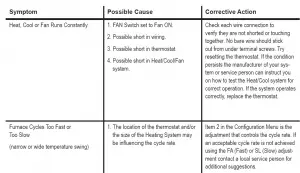
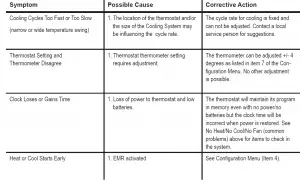
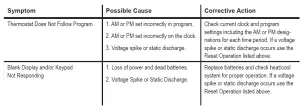
CONTACT US
Customer support: 877.654.9394 or [email protected]
MERCURY NOTICE
This product does not contain mercury. However, this product may replace a product that contains mercury.
Mercury and products containing mercury must not be discarded in household trash.
Refer to thermostat-recycle.org for location to send product containing mercury.
FOR CALIFORNIA RESIDENTS
Warning: This product contains a chemical known to the state of California to cause cancer and birth defects and other reproductive harm.
